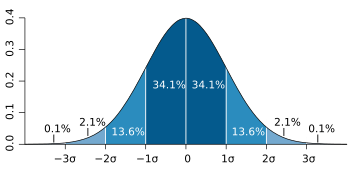Probability distribution facts for kids

Probability distribution is a term from mathematics. Suppose there are many events with random outcomes. A probability distribution is the theoretical counterpart to the frequency distribution. A frequency distribution simply shows how many times a certain event occurred. A probability distribution says how many times it should have occurred in the long run (that is, its probability). The probability distribution of a random variable  is often written as
is often written as  (or simply
(or simply  ). Such a distribution can either be discrete, taking a discrete (or countable) amount of values, or continuous, taking an uncountable amount of values (as from a continuous interval).
). Such a distribution can either be discrete, taking a discrete (or countable) amount of values, or continuous, taking an uncountable amount of values (as from a continuous interval).
As an example, the probability distribution for a single roll of a normal 6-sided dice can be presented by:
| Result |  |
 |
 |
 |
 |
 |
|---|---|---|---|---|---|---|
| Probability of result |  |
 |
 |
 |
 |
 |
where result is the outcome of the dice roll, and the probability shows the chances of that result occurring. If we roll a dice 60 times, then in the long run, we should expect to have each side appear 10 times on average.
There are different probability distributions. Each of them has its use, its benefits and its drawbacks. Some common probability distributions include:
- Binomial distribution
- Cauchy distribution
- Chi-square distribution
- Exponential distribution
- Gumbel distribution
- Normal distribution
- Poisson distribution
- Student's t-distribution
Related pages
Images for kids
See also
 In Spanish: Distribución de probabilidad para niños
In Spanish: Distribución de probabilidad para niños


